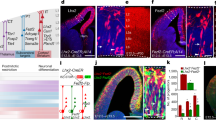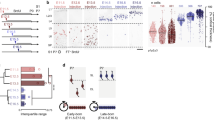Abstract
In the developing cerebral cortex, cell-extrinsic and cell-intrinsic signals govern the establishment of neuron subtype-specific identity. Here we show that, within the niche of the striatum, the expression of a single transcription factor, Fezf2, is sufficient to generate corticofugal neurons from progenitors fated to become medium spiny neurons. This demonstrates that a specific population of cortical projection neurons can be directed to differentiate outside of the cortex by cell-autonomous signaling.
This is a preview of subscription content, access via your institution
Access options
Subscribe to this journal
Receive 12 print issues and online access
$209.00 per year
only $17.42 per issue
Buy this article
- Purchase on Springer Link
- Instant access to full article PDF
Prices may be subject to local taxes which are calculated during checkout



Similar content being viewed by others
References
Molyneaux, B.J., Arlotta, P., Menezes, J.R. & Macklis, J.D. Nat. Rev. Neurosci. 8, 427–437 (2007).
Rallu, M., Corbin, J.G. & Fishell, G. Nat. Rev. Neurosci. 3, 943–951 (2002).
Schuurmans, C. & Guillemot, F. Curr. Opin. Neurobiol. 12, 26–34 (2002).
Schuurmans, C. et al. EMBO J. 23, 2892–2902 (2004).
Arlotta, P. et al. Neuron 45, 207–221 (2005).
Molyneaux, B.J. et al. J. Neurosci. 29, 12343–12354 (2009).
Chen, B., Schaevitz, L.R. & McConnell, S.K. Proc. Natl. Acad. Sci. USA 102, 17184–17189 (2005).
Chen, J.G., Rasin, M.R., Kwan, K.Y. & Sestan, N. Proc. Natl. Acad. Sci. USA 102, 17792–17797 (2005).
Molyneaux, B.J., Arlotta, P., Hirata, T., Hibi, M. & Macklis, J.D. Neuron 47, 817–831 (2005).
Wichterle, H., Turnbull, D.H., Nery, S., Fishell, G. & Alvarez-Buylla, A. Development 128, 3759–3771 (2001).
Mattar, P. et al. Mol. Cell. Biol. 28, 1456–1469 (2008).
Campbell, K., Olsson, M. & Bjorklund, A. Neuron 15, 1259–1273 (1995).
Fishell, G. Development 121, 803–812 (1995).
Magrassi, L. et al. Development 125, 2847–2855 (1998).
Acknowledgements
We thank J. Macklis (Harvard University) for reagents and advice; E. Abdel-Azim, G. Srubek-Tomassy, F. Zhang and S. Lodato for their comments; R. Hevner, (University of Washington), C. Lois (M.I.T.), K. Campbell (University of Cincinnati) and Q. Ma (Harvard Medical School) for generous sharing of antibodies, probes and expression vectors; and A. Meleski, A. Merlino and Z. Trayes-Gibson for technical support. This work was partially supported by grants to P.A. from the US National Institutes of Health (NS062849), the Spastic Paraplegia Foundation, the Harvard Stem Cell Institute and the Harvard NeuroDiscovery Center to P.A.; C.R. was partially supported by a Milton-Safenowitz postdoctoral fellowship from the ALS Association.
Author information
Authors and Affiliations
Contributions
P.A. and C.R. conceived the experiments and wrote the manuscript. P.A. supervised the project and C.R. executed all the experiments.
Corresponding author
Ethics declarations
Competing interests
The authors declare no competing financial interests.
Supplementary information
Supplementary Text and Figures
Supplementary Figures 1–5 and Supplementary Methods (PDF 4606 kb)
Rights and permissions
About this article
Cite this article
Rouaux, C., Arlotta, P. Fezf2 directs the differentiation of corticofugal neurons from striatal progenitors in vivo. Nat Neurosci 13, 1345–1347 (2010). https://doi.org/10.1038/nn.2658
Received:
Accepted:
Published:
Issue Date:
DOI: https://doi.org/10.1038/nn.2658
This article is cited by
-
Transcriptomic evidence that von Economo neurons are regionally specialized extratelencephalic-projecting excitatory neurons
Nature Communications (2020)
-
Strategies for assembling columns and layers in the Drosophila visual system
Neural Development (2018)
-
Subtype Specification of Cerebral Cortical Neurons in Their Immature Stages
Neurochemical Research (2018)
-
Direct conversion of human fibroblasts to functional excitatory cortical neurons integrating into human neural networks
Stem Cell Research & Therapy (2017)
-
Induction of specific neuron types by overexpression of single transcription factors
In Vitro Cellular & Developmental Biology - Animal (2016)



